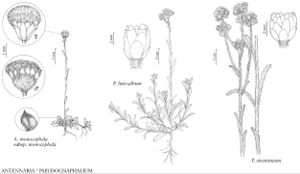Difference between revisions of "Pseudognaphalium luteoalbum"
Bot. J. Linn. Soc. 82: 206. 1981.
FNA>Volume Importer |
FNA>Volume Importer |
||
| Line 27: | Line 27: | ||
|elevation=5–2000 m | |elevation=5–2000 m | ||
|distribution=Ariz.;Ark.;Calif.;Fla.;La.;Nev.;N.Mex.;N.Y.;Oreg.;Tex.;Utah;Wash.;Mexico;Europe;Asia;Africa;Pacific Islands (New Zealand);Australia. | |distribution=Ariz.;Ark.;Calif.;Fla.;La.;Nev.;N.Mex.;N.Y.;Oreg.;Tex.;Utah;Wash.;Mexico;Europe;Asia;Africa;Pacific Islands (New Zealand);Australia. | ||
| − | |discussion=<p>Pseudognaphalium luteoalbum is native to Eurasia. It is similar in overall habit to P. stramineum but distinctive in its larger heads and red-tipped corollas (visible through the translucent phyllaries). Cypselae of P. luteoalbum have papilliform hairs; cypselae of other North American species of Pseudognaphalium are glabrous.</p> | + | |discussion=<p><i>Pseudognaphalium luteoalbum</i> is native to Eurasia. It is similar in overall habit to <i>P. stramineum</i> but distinctive in its larger heads and red-tipped corollas (visible through the translucent phyllaries). Cypselae of <i>P. luteoalbum</i> have papilliform hairs; cypselae of other North American species of <i>Pseudognaphalium</i> are glabrous.</p> |
|tables= | |tables= | ||
|references= | |references= | ||
| Line 52: | Line 52: | ||
|publication year=1981 | |publication year=1981 | ||
|special status= | |special status= | ||
| − | |source xml=https://jpend@bitbucket.org/aafc-mbb/fna-data-curation.git/src/ | + | |source xml=https://jpend@bitbucket.org/aafc-mbb/fna-data-curation.git/src/8f726806613d60c220dc4493de13607dd3150896/coarse_grained_fna_xml/V19-20-21/V19_680.xml |
|tribe=Asteraceae tribe Gnaphalieae | |tribe=Asteraceae tribe Gnaphalieae | ||
|genus=Pseudognaphalium | |genus=Pseudognaphalium | ||
Revision as of 16:14, 18 September 2019
Annuals, 15–40 cm; taprooted or fibrous-rooted. Stems loosely white-tomentose, not glandular. Leaf blades (crowded, internodes 1–5, sometimes to 10 mm) narrowly obovate to subspatulate, 1–3(–6) cm × 2–8 mm (distal smaller, oblanceolate to narrowly oblong or linear), bases subclasping, usually decurrent 1–2 mm, margins weakly revolute, faces mostly concolor to weakly bicolor, abaxial gray-tomentose, adaxial usually gray-tomentose, sometimes glabrescent, neither glandular. Heads in terminal glomerules (1–2 cm diam.). Involucres broadly campanulate, 3–4 mm. Phyllaries in 3–4 series, silvery gray to yellowish (hyaline), ovate to ovate-oblong, glabrous. Pistillate florets 135–160. Bisexual florets 5–10 (corollas red-tipped). Cypselae not evidently ridged (conspicuously dotted with whitish, papilliform hairs; pappus bristles loosely coherent basally, released in clusters or easily fragmented rings). 2n = 14, 16, 28.
Phenology: Flowering Apr–Oct.
Habitat: Roadsides, fields and pastures, ditches, streambanks, seasonal ponds, gardens, and other disturbed sites
Elevation: 5–2000 m
Distribution

Ariz., Ark., Calif., Fla., La., Nev., N.Mex., N.Y., Oreg., Tex., Utah, Wash., Mexico, Europe, Asia, Africa, Pacific Islands (New Zealand), Australia.
Discussion
Pseudognaphalium luteoalbum is native to Eurasia. It is similar in overall habit to P. stramineum but distinctive in its larger heads and red-tipped corollas (visible through the translucent phyllaries). Cypselae of P. luteoalbum have papilliform hairs; cypselae of other North American species of Pseudognaphalium are glabrous.
Selected References
None.
